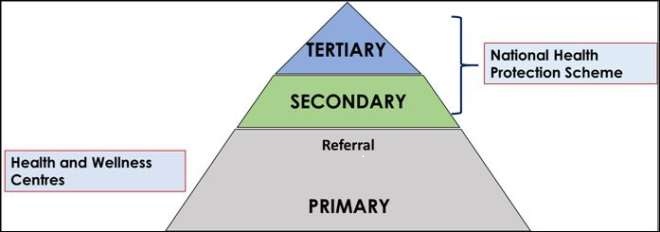All India Radio
Ayushman Bharat-Healthcare Scheme
Search 5th February 2018 http://www.newsonair.com/Main_Audio_Bulletins_Search.aspx
TOPIC: General Studies 2
- Government policies and interventions for development in various sectors and issues arising out of their design and implementation.
- Welfare schemes for vulnerable sections of the population by the Centre and States and the performance of these schemes
The biggest takeaway from union budget 2018-19 is the National Health Protection Scheme. This is a part of current government’s Ayushman Bharat project. It is an ambitious scheme which has generated hope and anxiety because it is world’s largest government funded healthcare programme.
Two flagship initiatives under Ayushman Bharat
- Creation of primary healthcare foundation of India which is comprehensive, close to people, provides first level care to people near their houses and launches Jan Andolan for public health care.
- To provide people secondary and tertiary care, connect poor and vulnerable population to this system, the scheme is NPS. It is aspirational scheme covering significant population of India it builds on previous experiences of similar schemes on small scale. This is built on several schemes that state governments have launched from time to time.

Picture credits: http://images.assettype.com/swarajya/2018-02/4d5b4182-6cd1-4b64-9734-af8e54445120/health.JPG?w=661&q=60&fmt=pjpeg&auto=format
The first pillar targets building of 150,000 health and wellness centres that will provide a broader package of services. At present, one sub-centre is expected to cater to the health requirements of approximately 5,000 people where most of the services are focused at maternal and child care as well as treatment of common illnesses like diarrhea.
The second pillar is providing an annual cover of Rs 5 lakh each for 10 crore families who will be identified on the basis of the socio-economic caste census data. Today, India has one of the highest levels of out-of-pocket spending on health, estimating around more than 60% which pushes many people below poverty line.
Thus, the aspiration of India’s political leadership at the state and central level to move in the direction of providing financial protection shield to the people of India has once again gained prominence and aim is to bring bottom 40% people into system where they can access care. As health is a state subject and will be expected to pay 40% of the funds for the scheme, it will be a classic example in making for cooperative federalism as state governments will be the implementers of the programme. States are custodians and implementers of the scheme and hence, final shape of the scheme will be done with consultations of the state.
Funding issues
A token money has been allocated for the beginning of the preparation of scheme but still there will be sometime to actual launch of the scheme. In the first year, the uptake would build up as it is a scheme where things are being set.
Structure of NHPS
State would need an agency which is the execution system of the state- whether society or a trust. This system can itself implement the scheme, purchase services and pay. Here, the liability is with the state government directly. This is called trust model. But if the state society or trust may not do it directly, they will have the task of managing the scheme in terms of identifying the beneficiaries, giving benefits, controls on hospitals, by empaneling insurance company. If that happens, it is called insurance model. Karnataka, Andhra Pradesh have trust models whereas Maharashtra, Rajasthan and Tamil Nadu are running insurance mechanism. Thus, atleast from the beginning, refining will done gradually. There will strong analytics and learning arm within the states to learn the successful re-engineering of the programme according to health requirements of the people of the state.
In this task, the states will have a choice. The duty of central government is to provide the choices, share the experiences, bring out various packages and preparing necessary guidelines.
What kind of hospitalization costs will be covered?
The estimation of costs is in preparation. Cost of packages will be tentative which will be decided by National Health Agency which will govern the implementing mechanism. States should have some flexibility as costs could vary in tier 1 cities and tier 2 cities. This money will be provided to the hospitals which give services. There are approx. 1200 packages options which includes doctor fees, tests, disposables and some care post discharge etc. Thus, it is a complete package.
Taking care of-
- State subject and state ownership is subject to its state policies. Politics can well derail the health upkeep process.
- Limited and uneven distribution of human resources at public health services is still a challenge with upto 40% posts still vacant in many states.
- Many programmes on health and family welfare, but none are linked with each other thereby not providing the best services to the needy.
- Clarity required on provision of government services and when to approach private parties.
Conclusion
It is important to emphasize that there will be no “one size fits all” model as far as these health and wellness centres is concerned. Lessons will need to be drawn from different primary care models that are being piloted and implemented in various states. The state and central agency will keep an eye that system is not distorted. For a system of this magnitude in any country, strong monitoring and governance system is required. Help of IT and artificial intelligence will also be taken. Moreover, there should be a link between institutions or hospitals, with health centres and the community as community engagement helps in planning and implementation of programme.
Take note:
The NHPS is built on already existing Rashtriya Swasthya Bima Yojna or RSBY – a health insurance scheme for the below poverty line families, with entitlement of upto Rs 30,000 per annum for diseases requiring hospitalization.
Connecting the dots:
- ‘Only healthy people can build prosperous nation.’ Critically analyse.











